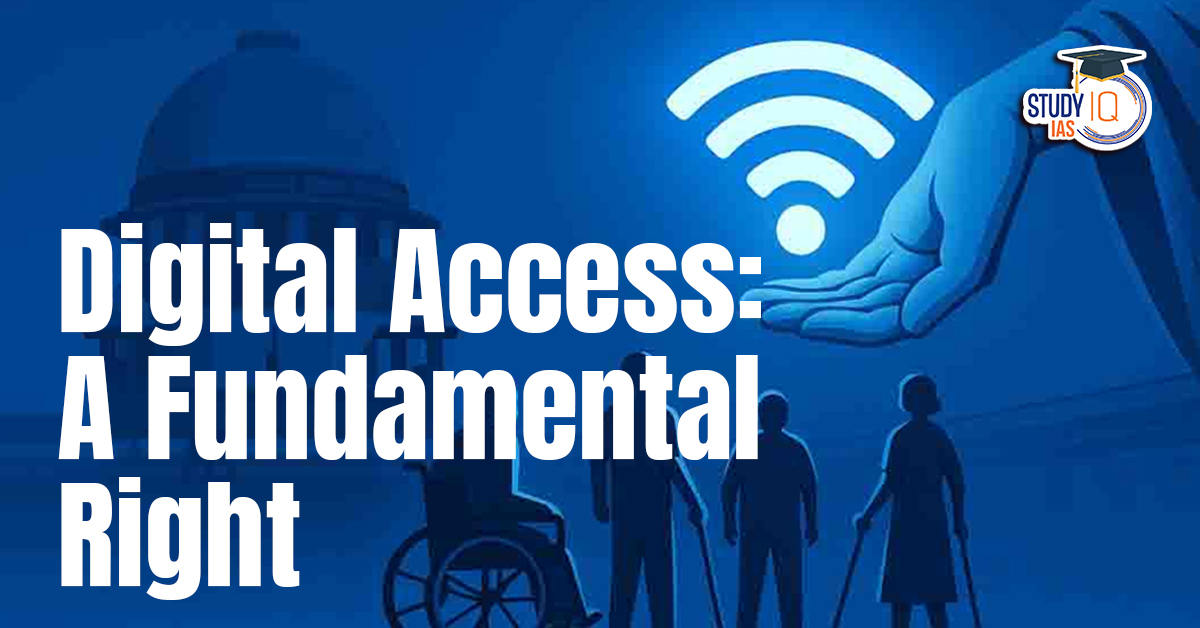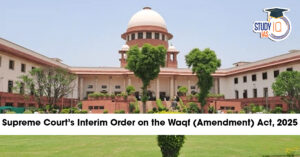Table of Contents
The Supreme Court of India has recently ruled that access to digital infrastructure is an essential component of the fundamental right to life and personal liberty, as guaranteed under Article 21 of the Constitution. This significant decision establishes that the government has a constitutional obligation to create a digital environment that is equitable and accessible to all individuals, ensuring that no citizen is excluded due to technological barriers. By recognizing digital access as a fundamental right, the judgment underscores the importance of bridging the digital divide and fostering an inclusive digital ecosystem that supports education, employment, governance, and other essential services.
Digital Access as a Part of Fundamental Right
Case Analysis: Amar Jain v. Union of India and ORS., W.P.(C) No. 49/2025 & Pragya Prasun VS. Union of India W.P.(C) No. 289/ 2024
Mandated Revisions to Digital KYC
The Supreme Court mandated that the existing digital KYC process be revised to assist those who face challenges, particularly acid attack survivors with facial disfigurements and individuals with visual impairments. The current system involves requirements like live photographs, head positioning, or rapid verification steps that many persons with disabilities find nearly impossible to fulfill.
Digital Access as a Constitutional Right
Anchoring its decision in Article 21 (the right to life and liberty), the Court redefines contemporary “life” to include the digital realm. Today, essential services such as banking, e-governance, healthcare, and education are primarily delivered online. Consequently, ensuring universal digital access isn’t merely a policy preference but a constitutional mandate.
Inclusive Digital Ecosystem
The judgment emphasises that the state has an obligation to construct a digital infrastructure that is inclusive for all, especially for marginalised or vulnerable groups. This means that digital portals, learning platforms, and financial services must be designed to eliminate barriers, ensuring that persons with disabilities, rural populations, senior citizens, and economically weaker communities all have equal access.
Protection Under Disability Rights
Recognizing that individuals who have suffered acid attacks or who have visual impairments are supported by the Rights of Persons with Disabilities Act, 2016, the Court has reinforced that they must receive reasonable accommodations. This reinforces that digital services should be sensitive to the needs of these users, including alternative verification and accessibility measures.
Broader Implications
Beyond just easing the procedural difficulties for specific groups, the judgment underscores that bridging the digital divide is essential to ensuring a dignified life in a digital era. The decision establishes that digital inclusion, seen through the lens of substantive equality, is a core aspect of the fundamental right to life.
By ordering comprehensive directions (twenty in total, as noted) to revamp the digital KYC framework, the Court charts a new course where technological progress and constitutional guarantees go hand in hand. This landmark decision doesn’t just alleviate immediate hurdles; it sets a precedent for a more equitable digital future in which every citizen, regardless of physical or situational limitations, can participate fully in modern society.
This judgment invites wider reflections on the balance between technology and human rights. As all essential services migrate online, scaling digital inclusion becomes critical. It also poses new challenges, such as how to ensure that other traditionally disadvantaged groups can navigate the digital space with dignity and autonomy.

A Constitutional Mandate for Digital Inclusion
The Supreme Court recognized that as daily life shifts to a digital platform—encompassing not only financial transactions but also essential services like education, healthcare, and governance, accessibility becomes an integral part of citizens’ right to live with dignity. By invoking Articles 21 (right to life), 14 (equality), 15 (non-discrimination), and 38 (Directive Principles of State Policy), the Court affirmed that the state must ensure that no one is left behind as services move online.
This means creating a digital ecosystem that is inherently inclusive, providing equal access to all segments of society, including marginalised, underprivileged, disabled, and historically excluded communities. This reinterpretation of constitutional rights is a forward-looking move to ensure that digital transformation does not widen the gap in social and economic participation.
The Need for Revising Digital KYC Processes
The judgment arose from real-world struggles faced by individuals with disabilities. Acid attack survivors and visually impaired persons, for instance, encounter significant challenges with the existing digital Know Your Customer (KYC) protocols. The process, as it stands, requires users to execute specific physical tasks such as blinking, maintaining precise head positions, or positioning their faces within digital frames, a set of requirements that do not accommodate those with facial disfigurements or impairments.
Recognizing these obstacles, the Court issued 20 directions to the government to overhaul the KYC system, making it more accessible through reasonable modifications and alternative verification methods. This directive ensures that digital processes become tools of inclusion rather than barriers to welfare and economic participation.
Addressing the Digital Divide
The concept of the “digital divide” refers to the gap between those who have access to modern digital technologies and those who do not. This divide is not just a matter of infrastructure but also of skills, literacy, and cultural inclusivity. The Court highlighted that while India is riding a “wave of digital progress” with initiatives like Aadhaar and net banking, significant portions of the population still remain excluded.
This includes not only persons with disabilities but also rural populations, senior citizens, economically weaker communities, and linguistic minorities who face hurdles such as poor internet connectivity and limited digital skills, compounded by the lack of digital content in regional languages. By stressing the need to bridge this divide, the judgment positions digital accessibility as a constitutional imperative, reinforcing that evolution in digital technology must be matched by equitable policies and inclusive design.
The Broader Philosophy: Substantive Equality in Digital Transformation
The Court’s reasoning rests heavily on the principle of substantive equality. This principle goes beyond formal equality by ensuring that policies and systems actively address inherent disadvantages faced by certain groups. For digital transformation, this means that the design of online platforms from government portals to financial services must be responsive to the needs of every citizen.
Justice Mahadevan’s articulation underlines that technology should serve as a bridge rather than a barrier. Ensuring accessible digital interfaces, assisted technologies, and alternative verification methods is essential to allow everyone to make use of digital public services. In other words, if digital systems exclude even a segment of the population, they undermine the very constitutional protections guaranteed to every citizen.
Practical Implications and Future Directions
The directives issued by the Court are not merely aspirational; they carry practical requirements. The government is now tasked with conducting digital accessibility audits, revising existing protocols, and ensuring that updates are implemented not only in financial services but across all platforms delivering essential services. For instance, online banking and e-governance portals must be redesigned with assistive features such as voice commands, screen-reader compatibility, and customizable interfaces that accommodate users with different disabilities.
The judgment sets a precedent for future cases and policies, urging a holistic approach where technology is harmonised with human rights. It is a reminder that with the rapid digital evolution, ongoing assessments and updates are necessary to prevent the exclusion of any demographic, thereby preserving a society built on the values of dignity, equality, and justice.
This landmark decision is a clarion call for India to ensure that the digital revolution does not leave behind its most vulnerable citizens. It redefines the right to life in the 21st century, making it clear that digital inclusion is central to achieving substantive equality. As services increasingly shift online, the emphasis must now be on creating digital ecosystems that empower everyone irrespective of their physical abilities, geographic location, or socio-economic status.
Constitutional Aspect
Article 21 – Right to Life with Dignity
Article 21 of the Constitution guarantees the right to life, which the judiciary has interpreted as not just mere survival but a life lived with dignity. In today’s digital era, the quality of life is increasingly tied to one’s ability to access essential digital services. The ruling reinforces that if a person’s digital needs, such as accessing banking, education, healthcare, or government services, are not met, their right to a dignified life is compromised. This places an onus on the state to construct digital services that respect and enhance personal dignity.
Article 14 – Right to Equality
The right to equality under Article 14 ensures that every citizen is treated equally under the law. This principle extends to digital accessibility. If online services are designed in ways that favour only those with adequate digital skills or specific physical abilities, then they inherently discriminate against vulnerable groups. The ruling underscores that the digital infrastructure must be reformed so no one is left behind, ensuring that all citizens from all walks of life enjoy equal access to state services.
Article 15 – Protection Against Discrimination
Article 15 protects citizens from discrimination on various grounds. In the context of digital services, it means the government must avoid designing systems that leave behind people with disabilities, those from economically weaker backgrounds, or individuals in remote areas. The obligation is thus clear: digital systems and processes must be sensitive to the diverse needs of all community members, ensuring that nobody is excluded because of factors such as disability, geographical location, or socio-economic status.
Article 38 – State’s Duty to Promote Welfare and Reduce Inequality
Article 38 mandates that the state work actively to promote the welfare of its citizens while striving to reduce inequality. In the digital context, this translates to ensuring that every digital service, from online banking to e-governance platforms, is accessible to all, including marginalised and overlooked communities. The ruling therefore reinforces that a robust digital ecosystem is not only a technological necessity but also a means to bridge social and economic divides.
Precedent for Digital Policies
This landmark judgment sets a strong precedent for all future digital policies in India. By establishing that digital accessibility is not just a matter of progressive policy but a constitutional imperative, the ruling lays down a framework that must be followed in the development of all future digital platforms. Lawmakers and regulators will now be guided by the principle that any technological advancement must take into account the needs of all citizens, especially the most vulnerable.
Focus on Vulnerable Populations in Technological Advancements
The ruling marks a pivotal shift in how digital services are conceptualised and deployed. Recognising that technology can inadvertently exclude segments of the population, it calls for reforms that are sensitive to these risks. This means that future efforts to digitise government services, finance, healthcare, and education will be expected to incorporate universal design principles. This proactive stance helps ensure that advancements in digital technology contribute positively to social equity and are aligned with the broader constitutional goals of welfare and reduced inequality.
Broader Reforms in Service Delivery
Beyond just the KYC process, the directive has broader implications for the overall design and delivery of digital services. It may spur a reevaluation of all existing digital platforms to ensure they are inclusive, prompting systemic reforms in how the state delivers its services. In the long run, these changes could lead to an entire ecosystem where digital access becomes a tool for empowerment and equal participation in civic and economic life.
In conclusion, the judgment is a comprehensive rearticulation of the state’s duty to ensure digital inclusion under the Constitution. By aligning the digital realm with constitutional guarantees under Articles 21, 14, 15, and 38, the ruling reinforces that every digital advancement must be accessible to all citizens, setting a robust framework for future digital policies and reforms. This ensures that as India strides forward technologically, no one is left behind.


 Reserved vs General Quota: Supreme Court...
Reserved vs General Quota: Supreme Court...
 Supreme Court’s Interim Order on the W...
Supreme Court’s Interim Order on the W...














